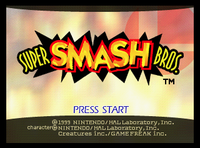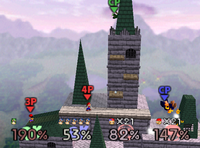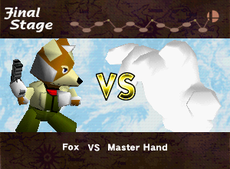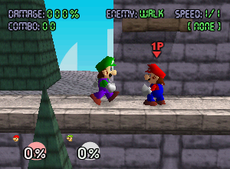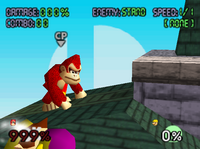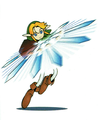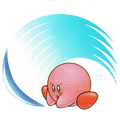Super Smash Bros.
- This article is about the game Super Smash Bros. for the Nintendo 64. For the series as a whole, see Super Smash Bros. (series).
| Super Smash Bros. | |||||||||
|---|---|---|---|---|---|---|---|---|---|
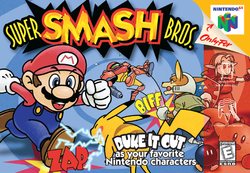 For alternate box art, see the game's gallery. | |||||||||
| Developer | HAL Laboratory | ||||||||
| Publisher | Nintendo | ||||||||
| Platform(s) | Nintendo 64 Virtual Console (Wii) | ||||||||
| Release date | Nintendo 64: Virtual Console (Wii): | ||||||||
| Language(s) | Deutsch English (United Kingdom) English (United States) Français (France) 日本語 简体中文 | ||||||||
| Genre | Fighting | ||||||||
| Rating(s) |
| ||||||||
| Mode(s) | 1-4 players | ||||||||
| Media | Nintendo 64:
iQue Player:
Wii: | ||||||||
| Input | Nintendo 64: iQue Player: Wii:
| ||||||||
Super Smash Bros. is a fighting game and the first installment in the Super Smash Bros. series. It was released for the Nintendo 64 in 1999 and created by Nintendo and HAL Laboratory. Playing as one of a selection of Nintendo characters, players aim to defeat their opponents by knocking them off the screen. The game also features several Nintendo-themed stages and items.
The Super Mario franchise is among the Nintendo franchises to be represented in the game by characters, stages, and items.
Gameplay[edit]
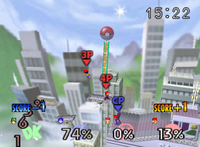
Super Smash Bros. has a considerably different fighting style than other fighting games. Rather than each player having a life gauge that begins full and gradually decreases with each attack taken, Super Smash Bros. has a unique system. Players starts at 0% damage and with each hit they take, the percentage rises depending on how powerful the attack is. As players' percentage gets higher, players are blown further away with each attack. The objective of the game is to knock out opponents from the screen so they cannot return to the stage or knocking out opponents off the top of the screen, so that they turn into a star. Getting defeated by an opponent is called a "KO". In time mode, this results in a loss of one point, while in stock mode, this counts as a loss of one life. Players regenerate on a descending floating platform at the center of the stage, unless they have no lives left. Players can exit by either moving, jumping, or waiting a few seconds. Players are invincible for a short amount of time after they exit the platform.
Items are also an important component of the game. Depending on the settings set in the menu, the frequencies and types of items appearing can be altered. Some items are more powerful than others, while some are used to heal the user rather than attack an opponent.
Compared to later Super Smash Bros. games, the characters can only throw another character forwards, and the only dodge-related technique is rolling.
Below are specific rules and differences between the two fighting modes: Time and Stock.
Time[edit]
In Time mode, KOs count as one negative point for players that are knocked out of the screen. Players that caused them to fall receives one positive point and is recorded as a "KO". If a player accidentally or intentionally falls off the stage without being influenced by other players, or if the player hits a wall before being KO'd, the player loses one point while nobody gains a point. At the end of the time period, a player that has the most points is declared the winner.
If there is a tie, then the match goes to Sudden Death. The tied players have a quick stock battle with one life, starting with 300% damage, which usually causes an instant KO when hit. Also, after a certain time, Bob-ombs start falling at random places on the stage, making survival more difficult. The winner of Sudden Death wins the match.
Stock[edit]
In stock mode, there is still a point system, but wins are focused on number of lives left. Each player begins with a set amount of lives. Each time a player is defeated, they lose one life. Unlike Time mode, the number of KOs are irrelevant to the results because it is a game of survival unless it is a team match. This also means that matches could theoretically be endless.
If there is a tie, a tiebreaker called a Sudden Death match occurs, where all players begin with 300% damage and one life. The last one standing wins.
Players can fight alone or in teams. Allies cannot be hurt by other teammates unless team attack is turned on. Also, if players manage to defeat an ally, they get a point while the ally loses a point, unlike in the succeeding games where both teammates lose a point. If a team wins, players in the team with the most KOs gets the first place honor.
This is the only game that shows who KO'd whom during a stock match.
Playable characters[edit]
Super Smash Bros. features 12 playable characters from various Nintendo franchises, eight being default and four of them are unlockable. Of the roster, there are four characters from the Super Mario franchise; Mario, Luigi, Donkey Kong, and Yoshi, although Donkey Kong and Yoshi each have their own logo since they are protagonists within their own games.
Default characters[edit]
| Character | Franchise | Description | Special moves | ||
|---|---|---|---|---|---|
| Standard | Up | Down | |||
 Mario |
Super Mario | Mario has average speed and weight, but has very good jumping abilities and strong attacks. His Fireballs are bouncy, similar to most Super Mario games. | Fireball | Super Jump Punch | Mario Tornado |
 Donkey Kong |
Donkey Kong | Donkey Kong is one of the strongest characters and is a heavy-weight character. When he picks up a character, he can carry them for a short distance. He can also charge up his Giant Punch to make it more powerful. | Giant Punch | Spinning Kong | Hand Slap |
 Link |
The Legend of Zelda | Link is a character with medium weight, strength and speed. Most of his attacks center around his sword, and Link also has a number of projectiles in Bombs and a Boomerang. | Boomerang | Spin Attack | Bomb |
 Samus |
Metroid | Samus is a slow and heavy character with powerful attacks. Her Grapple Beam allows her to grab characters from far away, and she can power up her Charge Shot for a stronger attack. | Charge Shot | Screw Attack | Bomb |
 Yoshi |
Yoshi | Yoshi is a fast and middleweight fighter with strong smash attacks. Unlike other fighters, Yoshi's shield is not an energy bubble but a green-spotted Yoshi Egg. He does not have a third jump, but his second jump gives him a knockback immunity to make up for that. | Egg Lay | Egg Throw | Yoshi Bomb |
 Kirby |
Kirby | Kirby is a light, fast character. He can multi-jump in the air and his special Swallow move allows him to copy other characters' abilities. | Swallow | Final Cutter | Stone |
 Fox |
Star Fox | Fox is a fast but heavy character with average strength. His blaster can stun opponents, thus stopping them in their tracks. He can use his Reflector to reflect projectiles, including thrown items. | Blaster Show | Fire Fox | Reflector |
 Pikachu |
Pokémon | Pikachu is fast and light. It mostly uses its electric attacks to damage other enemies. Pikachu has weak attacks as well. | Thunder Jolt | Quick Attack | Thunder |
Unlockable characters[edit]
| Character | Franchise | Description | How to unlock | Special moves | ||
|---|---|---|---|---|---|---|
| Standard | Up | Down | ||||
 Luigi |
Mario | Luigi is a character with average weight and speed but with above average strength. His moves look similar to Mario's, but they function very differently. His Super Jump Punch can be very strong if he uses it while adjacent to an opponent, but otherwise it is a very weak attack. His Luigi Cyclone makes opponents fly away. His fireballs float in a straight line instead of bouncing. He also jumps higher than Mario, but he is also slower and lighter. | Clear Break the Targets with all default characters. | Fireball | Super Jump Punch | Luigi Cyclone |
 Ness |
EarthBound | Ness is a fast and light character. He uses a homerun bat and a yo-yo for his Smash Attacks. He has to direct a PK thunder into himself in order to utilize his third jump. Ness can use his PSI magnet to absorb most projectiles to heal himself. | Clear 1-Player Game without continuing on normal difficulty with 3 lives. | PK Fire | PK Thunder | PSI Magnet |
 Captain Falcon |
F-Zero | Captain Falcon is the fastest character in the game. He is a heavyweight fighter, his special attacks are all fiery, and the Falcon Punch is the strongest one-hit attack of any character. | Clear 1-Player Game in under 20 minutes. | Falcon Punch | Falcon Dive | Falcon Kick |
 Jigglypuff |
Pokémon | Jigglypuff is weak and light. It has the ability to multi-jump in the air. Its rest attack can be lethal if it uses it adjacent to an opponent. Unlike most characters, it does not have a recovery move, but it can use Pound to gain distance while floating in the air. If its shield breaks, it flies up and usually gets KO'd. | Clear 1-Player Game. | Pound | Sing | Rest |
Opponents[edit]
Enemies[edit]
Bosses[edit]
Stages[edit]
Default stages[edit]
| Image | Stage | Basis | Description |
|---|---|---|---|

|
Peach's Castle | Super Mario 64 | A stage with one large platform, two mid-air sloped platforms at the side, and a moving platform towards the bottom. There are two bumpers in the upper right and left-hand corners of the stage. The challenger match against Luigi takes place here. |

|
Congo Jungle | Donkey Kong Country | A stage sloped towards the middle, with platforms on either side. There is also a Barrel Cannon moving side to side at the bottom of the stage. If players are to fall into it, the barrel would start rotating and the players press the |

|
Hyrule Castle | The Legend of Zelda: Ocarina of Time | A very long stage, and the first stage of the single-player mode. It does not have many gimmicks, except for a whirlwind that appears every 30 seconds. The tornado sends players flying with a percent cost, and it can turn unlucky players into stars depending on the location and percent. The tornadoes appear in 4 places in this stage. This stage is the home stage of Link. |

|
Planet Zebes | Super Metroid | A small stage that is easy to get blasted off of. The only other feature is the acid, that rises up about every 30 seconds. The acid hurts players and knocks the player out of the stage if the percent is high enough. The acid also makes it nearly impossible to score a KO in the bottom part of the stage. This stage is the home stage of Samus. Also, the challenger match against Captain Falcon takes place here, as the game features no stages from the F-Zero series. |

|
Yoshi's Island | Yoshi's Story | A stage slightly sloped on either side, meant to look like a book. There are also three mid-air platforms, two of which are also slanted. Clouds on the sides of the course can be stood on, but they disappear if the player stays on the platform for a period of time. This stage is the home stage of Yoshi. |

|
Dream Land | Kirby's Dream Land 3 | A flat stage, with Whispy Woods at the center. Whispy sometimes blows air that pushes players in the direction he is facing. This stage is the home stage of Kirby. Also, the challenger match against Ness takes place here, as the game features no stages from the EarthBound series. |

|
Sector Z | Star Fox 64 | A very large stage, set on the Great Fox. Occasionally, an Arwing enters the screen and fires blasts of beams at the players. The stage is the largest of the game, considering the length of the blast lines. This stage is the home stage of Fox. |

|
Saffron City | Pokémon Red, Green, Blue, and Yellow | A large stage that features the most gimmicks. It is the home stage of Pikachu and Jigglypuff, and the challenger match against Jigglypuff takes place on this stage. Various Pokémon emerge from the building in the middle, having effects on gameplay. |
Unlockable stage[edit]
| Image | Stage | Basis | Description | How to unlock |
|---|---|---|---|---|

|
Mushroom Kingdom | Super Mario Bros. | A large stage, featuring some gimmicks: moving platforms, Warp Pipes, and others. | Clear 1-Player Game with all default characters, and play each stage in VS Mode. |
1P-only stages[edit]
| Image | Stage | Basis | Description |
|---|---|---|---|

|
Meta Crystal | Super Mario 64 | A small stage with two small, uneven bumps and small platform over the rest of the stage. It is where Metal Mario is fought, with him patrolling the stage when not fighting. |

|
Battlefield | Original | A short, flat stone stage with three small platforms floating in a triangular array above. It is where the Fighting Polygon Team is fought. |

|
Final Destination | Original | A flat and featureless stage where Master Hand is fought. |
Items[edit]
There are many items throughout the game that can be used in battle. Items spawn randomly on the stage, and they disappear after being unused for long enough or being used to a certain extent. The following is a list of the game's items.
| Image | Name | Series | Description |
|---|---|---|---|

|
Crate, Capsule, Egg, and Barrel | Super Smash Bros. series | The Crate is a wooden box that contains a random item, which can be released by breaking it open or throwing it to the ground. Barrels are similar, but can roll along the ground if hit. Capsules and Eggs are lighter than Crates and Barrels. Sometimes these items explode. |

|
Bob-omb | Super Mario franchise | When grabbed and thrown at an enemy, this item explodes, but if left alone, it starts walking around until its timer reaches zero. |

|
Fire Flower | Super Mario franchise | The Fire Flower can be used to blast opponents at close range with fire. |

|
Green Shell | Super Mario franchise | The Green Shell can be thrown, and then slides along the ground, being able to hit multiple characters. The Green Shell disappears after being used a certain amount of times. |

|
Hammer | Donkey Kong series | A character that obtains the hammer starts automatically attacking with it (much like the original Donkey Kong arcade game), causing significant damage to opponents hit. |

|
Red Shell | Super Mario franchise | Similar to the Green Shell, but does less damage and homes in on characters. |

|
Star | Super Mario franchise | The Star makes the player invincible for several seconds. Players with this item do not take damage from their enemies and cannot be hit or grabbed. However, they can still fall off the stage and self-destruct. |

|
Beam Sword | Super Smash Bros. series | This is a sword that can be used to attack opponents with greater attack power. |

|
Home Run Bat | Super Smash Bros. series | This item can be very powerful; although it can't be thrown far, the player can use it to attack opponents and inflict a large amount of damage, usually an instant KO. |

|
Motion Sensor Bomb | GoldenEye 007 | When thrown, these activate wherever they land. The first character to approach an active bomb takes damage and is sent flying. |

|
Bumper | Super Smash Bros. series | When thrown, this item remains in the same spot. If any character, including the user, touches it, they take damage, and are pushed in a single direction. |

|
Fan | Super Smash Bros. series | Because it is light, this item is good for quick attacks. But it doesn't do much damage and can't be thrown very far. |

|
Poké Ball | Pokémon series | When thrown, the Poké Ball opens up, and a Pokémon pops out. The Pokémon that appears is random; it performs its special skill and leaves. |

|
Star Rod | Kirby series | When the Star Rod is used, stars come flying out of it, hitting other characters. If used with smash, a large star flies out. The Star Rod has only a limited amount of large stars it can shoot. |

|
Maxim Tomato | Kirby series | This is a healing item that restores up to 100% of damage. |

|
Heart Container | The Legend of Zelda series | The Heart Container fully reduces the player's damage to 0%. |

|
Ray Gun | Super Smash Bros. series | The Ray Gun can hit enemies from a distance with its long-range laser shot. |
Poké Ball Pokémon[edit]
A number of Pokémon can be released from the Poké Ball item, each coming from the Pokémon series' first generation. Each has a different effect, using a move from the series.
| Pokémon | Description |
|---|---|
Beedrill Bug/Poison |
A Poison Bee Pokémon, it summons a swarm of Beedrill to use Take Down on opponents. |
Blastoise Water |
A Shellfish Pokémon, it uses Hydro Pump to push opponents with gushes of water; however, this also slowly moves itself backwards. |
Chansey Normal |
An Egg Pokémon, it uses Soft-Boiled to scatter eggs across the field, which can be eaten to reduce damage or broken to reveal items or explosions. |
 Charizard Fire |
A Flame Pokémon, it uses Flamethrower to shoot short-range plumes of fire on either side of it back-and-forth. |
Clefairy Normal |
A Fairy Pokémon, it uses Metronome to imitate any other available Pokémon's ability. |
Goldeen Water |
A Goldfish Pokémon, it uses Splash to flop around ineffectually. |
Hitmonlee Fighting |
A Kicking Pokémon, it uses Jump Kick to make a single arcing attack towards opponents. |
Koffing Poison |
A Poison Gas Pokémon, it uses Poison Gas to surround itself with smog that damages opponents as long as they are caught in it. |
Meowth Normal |
A ScratchCat Pokémon, it uses Pay Day to rapidly fire coins from four directions at once around it. |
Mew Psychic |
A Legendary New Specie Pokémon, it does not use any move, but gives a large point bonus if found. |
 Onix Rock |
A Rock Snake Pokémon, it uses Rock Throw to shower the stage from above with boulders. |
Snorlax Normal |
A Sleeping Pokémon, it uses Body Slam to make itself huge and fall through the stage from above where it was called. |
Starmie Water/Psychic |
A Mysterious Pokémon, it uses Swift to line up with an opponent and launch a barrage of stars in a horizontal line from a fixed position. |
Stage gimmicks and hazards[edit]
It has been requested that more images be uploaded for this section. Remove this notice only after the additional image(s) have been added. Reason: Many of the sprites are missing
Certain characters and objects appear on the various stages in a capacity that affects gameplay.
| Entity | Description |
|---|---|
| Acid | Highly caustic liquid that rises from the pit in Planet Zebes every 30 seconds, often covering platforms. It damages and launches fighters that touch it. |
| Arwing | The standard ride of the Star Fox team, these occasionally appear in Sector Z, firing their lasers. |
 Barrel Cannon |
A floating barrel that rotates when entered and can be launched from by pressing an action button, it swings back and forth under Congo Jungle. |
| Bomb | Large, rolling explosives that appear in one section of Race to the Finish. |
| Brick Block | Cubes of bricks found floating in Mushroom Kingdom. Attacking or jumping into them breaks them. |
Bullet Bill |
Quick-moving rounds launched by Master Hand as one of his attacks. |
Bumper |
Automatically deployed versions of the Bumper item appear moving above Peach's Castle. |
Chansey |
An Egg Pokémon, Chansey appears from the building in Saffron City to use Soft-Boiled, dispensing item-containing or explosive eggs across the stage. |
Charmander |
A Lizard Pokémon, Charmander appears from the building in Saffron City to use Flamethrower, spitting fiery streams from its position. |
| Cloud | Clouds appear to the sides in Yoshi's Island, slowly fading away if stood on. |
 Cyclone |
A small but powerful whirlwind that appears in one of four places on Hyrule Castle every 30 seconds. |
Electrode |
A Ball Pokémon, Electrode appears from the building in Saffron City to use Explosion, blinking before blowing up and hurting anyone in the blast radius. |
| Pipe | A trio of green tubes that can be moved between in Mushroom Kingdom, though they are also the home of Piranha Plant. |
Piranha Plant |
A toothy flower who sometimes sprouts from the pipes in Mushroom Kingdom. |
Porygon |
A Virtual Pokémon, Porygon appears from the building in Saffron City to use Tackle, rushing out at high speed to launch anyone standing nearby. |
| POW Block | A special blue brick in Mushroom Kingdom that launches all opponents that are on the ground when it is hit. It only appears in certain areas. |
| Scale Lift | A pair of lifts in Mushroom Kingdom tied together by a rope and pulley. If either lift is pulled high enough to hit the pulley, both lifts fall. |
Venusaur |
A Seed Pokémon, Venusaur appears from the building in Saffron City to use Razor Leaf, shooting leaves in a straight line in front of it to damage fighters. |
Whispy Woods |
A surly tree in Dream Land who blows powerful gusts to either side for a few moments. |
Stage cameos[edit]
Many other characters appear as mere background cameos in stages relevant to their origin series.
| Entity | Description |
|---|---|
Bronto Burt |
Flying creatures and common enemies to Kirby, they appear in Dream Land. |
Butterfree |
A Butterfly Pokémon, they appear in Saffron City. |
Buzzy Beetle |
A squat, fireproof turtle, one bounces on a spring in Mushroom Kingdom. |
Fearow |
A Beak Pokémon, they appear in Saffron City. |
Flying Shy Guy |
Shy Guys with propellers and occasionally a melon, they appear in Yoshi's Island. |
Goonie |
Large white albatrosses that appear in Yoshi's Island. |
King Dedede |
A greedy ruler and Kirby's primary rival, he appears in Dream Land. |
Koopa Troopa |
A simple turtle who appears in Mushroom Kingdom. |
Lakitu Bro |
A cloud-riding cameraman turtle who appears at Peach's Castle. |
Moltres |
A Legendary Flame Pokémon, they appear in Saffron City. |
Necky |
Large vultures that appear in Congo Jungle. |
Pidgey |
A Tiny Bird Pokémon, they appear in Saffron City. |
 Ridley |
A gruesome space pirate and nemesis of Samus, he appears in Planet Zebes. |
  Space junk |
Pieces of derelict machines making up obstacles in the space graveyard of Sector Z. |
Modes[edit]
Single-player mode[edit]
1P Game[edit]
- SmashWiki article: 1P Game
In single-player mode, before a player starts the game, a character, difficulty level, and number of lives is selected. The difficulty levels range from Very Easy, Easy, Normal, Hard, to Very Hard. The number of lives can be set anywhere from one to five lives. The number of lives carries over from the previous match, which means any lost lives are not restored each level. Once the player loses all lives, they can choose to continue, but has their current score cut in half. Alternatively, they can quit, which results in a Game Over.
All stages work with the stock system and opponents and allies have one life each. There is a time limit of five minutes per match, but players can choose to disable it. If in the case the player runs out of time in a level with the exception of Bonus Stages, they go to the Continue screen (as if they had lost all of their lives), regardless of the number of lives the player had remaining.
Upon completing a main stage, the player may be awarded with special bonuses by completing certain tasks. There are a total of 55 bonuses with some only being obtainable on certain stages due to their unique hazards. Bonuses are not required to achieve and are purely for high-score setting purposes. Earning all bonuses in this game does not earn the player any reward of some sort, and no list is kept in the game when a bonus is achieved.
| One-player Game Stages | |
|---|---|
| Stage 1 | The player fights Link at Hyrule Castle. |
| Stage 2 | The player fights a team of 18 Yoshis in Yoshi's Island. The player fights three Yoshis at a time. When one is defeated, another one takes its place, until all are defeated. |
| Stage 3 | The player fights Fox in Sector Z. |
| Bonus Stage 1 | Break the Targets! The player has to hit the 10 targets within a time limit of 2 minutes. Each character has a different arena for his target test. Getting KO'd in the target test causes the failure of the test, but not the loss of a life. |
| Stage 4 | The player fights Mario and Luigi on Peach's Castle. The player also gets a randomly chosen ally. |
| Stage 5 | The player fights Pikachu in Saffron City. |
| Stage 6 | The player fights a Giant Donkey Kong in Congo Jungle. The player gets two randomly chosen allies. |
| Bonus Stage 2 | Board the Platforms! The player has to land on all 10 platforms within 2 minutes. It is similar to Break the Targets!!; the player can get KO'd and fail the test, but it doesn't constitute towards the loss of a life. |
| Stage 7 | The player fights a team of 8 Kirbys in Dream Land. Seven of them already have abilities from the other 7 default characters. The last one is either the regular Kirby or one with an ability of one unlockable character. The player fights two at a time. |
| Stage 8 | The player fights Samus on Planet Zebes. |
| Stage 9 | The player fights Metal Mario at Meta Crystal. |
| Bonus Stage 3 | Race to the Finish! The player has to reach the white door at the end while avoiding three Fighting Polygons, bombs, and bumpers within one minute. Like the two previous bonus stages, failure does not result in the loss of a life. |
| Stage 10 | The player fights a team of 30 Fighting Polygons on the Battlefield stage. The polygons are fought three at a time. |
| Final Stage | The player fights Master Hand. Unlike the player, the Master Hand does not have a percentage of damage, but 300 hit points. The battle takes place on Final Destination. |
Training mode[edit]
- SmashWiki article: Training Mode
Training mode allows players to practice and simulate battles for improving skills or for beginners to learn controls and moves. There is no time limit or a set number of lives, and whatever happens in Training mode is not recorded.
There are multiple adjustable factors within this mode that are not available in regular VS. mode. Primarily, the computer player's actions can be set to either Stand, Walk, Evade, Jump, or Attack. In any case, if the computer player is about to get knocked off the stage, they make an effort to recover. Another ability available from the pause menu is to be able to make any item spawn. Up to four items can be on the stage at once. The speed of the game is also adjustable. Besides normal speed, it can be set to 2/3, 1/2, or 1/4 speed. Lastly, the camera view can also be changed from normal to close-up; close-up view follows the player at a close angle.
Unlike later Super Smash Bros. games, the computer player cannot be controlled using a controller, and only one computer player can be present at a time. Also, a special backdrop is used, and music unique to the mode plays in place of the usual background music.
Bonus Practice[edit]
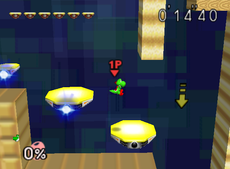
The final mode in single-player mode is Bonus Practice. There are two games, "Board the Platforms" and "Break the Targets". Both games appear as bonus stages in the One-player mode. Unlike other modes, if the player waits after selecting a character, the game automatically starts.
Board the Platforms![edit]
- SmashWiki article: Board the Platforms!
Each character has a unique stage that has ten platforms of various sizes. The objective is to land on each of the ten platforms in the least amount of time possible. Some platforms move while others must be jumped on with the correct timing or the player gets damaged. If the player falls from the stage, it is a Failure, and the player is sent back to the character selection screen.
Break the Targets![edit]
- SmashWiki article: Target Smash!
Similarly to Board the Platforms, Break the Targets has a unique stage for each player. The objective in this game is to break ten targets placed throughout the stage by hitting them with an attack. Like Board the Platforms, some targets move, while others are stationary. There are no extra lives, so once a player falls, the trial is a failure, and the player is brought back to the character selection screen.
Versus mode[edit]
- SmashWiki article: Versus Mode
In VS. mode, the game's only multiplayer mode, the player can pick up to four fighters to fight in a battle. A fighter selection screen is seen, and the players are able to pick which fighter they want. They can also select the costume color for each character. The player is also able to set rules for this match; in a time match, the player can pick the amount of time that can be played, and in a stock match, the players can pick the amount of the lives they and the computers have. Also, after playing a certain number of VS. matches, players can choose which items appear during matches (not in an order, as they are picked randomly). There's also a handicap setting, which allows human players to adjust their attack power and knockback resistance. The damage setting allows players to adjust how quickly fighters can get KO'd at low damage; ranging from a minimum of 50%, to a maximum of 200%.
The next screen is the stage selection screen, where players pick the stage to play on before the battle starts.
Besides the default Free-for-all mode in which players fight each other, there are also team battles. Players can divide into up to three teams and fight against the other team(s). Also, lives are shared, so if one player is eliminated from a team, given that another team mate has 2 or more lives remaining, the eliminated player can recover by borrowing one ally's life by pressing the ![]() . Teams are distinguished by costume color of each player, which is either red, green, or blue.
. Teams are distinguished by costume color of each player, which is either red, green, or blue.
Options[edit]
- SmashWiki article: Options
In the options mode, players can adjust a few game settings. They can adjust the sound to be mono or stereo. Super Smash Bros. is currently the only game in the series where players cannot adjust the music or sound effects volume. The next option is screen adjusting. Super Smash Bros. is also the only game in the series to have this option. The next option is the backup clear, which removes the game's data, which cannot be restored. The European version has an additional option for changing the game's language to English, French or German.
Data[edit]
- SmashWiki article: Data
The last menu, the records, shows the profile of each character (and any unlocked characters), which is very similar to trophies in later games in the Super Smash Bros. series. The next part is the VS. Records, where players can see how many KOs, TKOs, and SD's are recorded. By pressing ![]() , the player can see how each character is ranked by KOs, SDs, Win Percentage, etc. By pressing the button again, players can view the character's record in detail, showing how much damage was given or taken and the ratio of KOs to TKOs to a certain character. It also shows the character's share of total playtime by percentage.
, the player can see how each character is ranked by KOs, SDs, Win Percentage, etc. By pressing the button again, players can view the character's record in detail, showing how much damage was given or taken and the ratio of KOs to TKOs to a certain character. It also shows the character's share of total playtime by percentage.
The last of the records is the unlockable Sound Test. Players can hear sound effects, voices, and/or music from the game. Players can unlock the Sound Test by completing both Break the Targets and Board the Platforms with all characters.
Reception[edit]
Super Smash Bros. received mostly positive reviews, with criticism mostly directed towards the game's single-player mode.[4] GameSpot's former editorial director, Jeff Gerstmann, noted the single-player game "won't exactly last a long time".[4] Instead, he praised the multi-player portion of the game, saying that it is "extremely simple to learn".[4] He also praised the game's music, calling it "amazing". GameCritics.com's Dale Weir described Super Smash Bros. as "the most original fighting game on the market and possibly the best multiplayer game on any system".[5] There were criticisms, however, such as the game's scoring being difficult to follow. In addition, the single-player mode was criticized for its perceived difficulty and lack of features. It was deemed one of the ten best Super Mario games of all time by ScrewAttack from GameTrailers.[6] It was given an Editors' choice award from IGN.[7]
In Nintendo Power's review, they praise the game for its lively graphics and sound design and ease of control, but does criticize the game for having repetitive music. Satisfaction has the lower score of 7.3/10 while play control scored the highest at 8.2/10.[8]
| Reviews | |||
|---|---|---|---|
| Release | Reviewer, Publication | Score | Comment |
| N64 | Nintendo Power | 7.7/10 | Levi — "SSB excels as a multiplayer game, offering endless rematches and shouting matches." Armond — "For a "no brain" brawling game the design is fairly innovative." Jason — "It beats other fighting games with a one-two punch of powerhouse personality." |
| N64 | Peer Schneider, IGN | 8.5/10 | "I've been playing Smash Bros. since its Japanese release -- and I still love the game. But I have to admit that I spent most of the time playing the multiplayer modes. It's not that the one-player mode is bad -- HAL tried to add a bit of variety by offering bonus stages and team fights, but the order of your opponents never changes and you'll find yourself playing just to get the hidden stuff. But plug in a few more controllers and the game comes to life. The character balance may seem a bit unfair at first (watch out for Kirby and Pikachu), but every fighter has his weaknesses and can be defeated. Well, Jigglypuff is a different story... What a strange character. I sincerely hope Nintendo creates a sequel to this game on its next game console and includes not only the characters from the main game franchises, but also secondary and lesser known ones (Ganondorf, Wario, Toad, Meowth, Pit from Kid Icarus, Banjo-Kazooie -- the list is endless). As it stands, Smash Bros. is an excellent choice for gamers looking for a worthy multiplayer smash 'em-up. Players looking for a Tekken-killer on N64 will have to wait a bit longer." |
| N64 | Jeff Gerstmann, GameSpot | 7.5/10 | "The game is extremely simple to learn and reasonably easy to master. The one-player game won't exactly last a long time, unless you count the time you have to spend unlocking all four of the hidden characters. So, if you've got a crew of friends ready to pick a Nintendo character and throw down, then Super Smash Bros. is definitely worth a purchase." |
| Aggregators | |||
| Compiler | Platform / Score | ||
| Metacritic | 79 | ||
| GameRankings | 78.81% | ||
Sales[edit]
Super Smash Bros. was commercially successful, and quickly became a Player's Choice title. Super Smash Bros. is the fifth best-selling game for the Nintendo 64, selling 5.55 million copies worldwide; 1.97 million copies were sold in Japan,[9] 2.93 million have been sold in North America,[10] and 650,000 have been sold elsewhere, as of December 31, 2009.
Staff[edit]
- Main article: List of Super Smash Bros. staff
Director[edit]
- Masahiro Sakurai
Chief Programmer[edit]
- Yoshiki Suzuki
Programmers[edit]
- Kouichi Watanabe
- Yasuyuki Nagashima
- Yoshimi Takahashi
- Katsuhiro Sakoda
- Yoshiya Taniguchi
Development[edit]
Super Smash Bros. was developed by HAL Laboratory, a Nintendo second-party developer, during 1998. It began life as a prototype created by Masahiro Sakurai and Satoru Iwata in their spare time entitled 'Kakuto-Gēmu Ryūō' (格闘ゲーム竜王 ?, lit. "Dragon King: The Fighting Game"), and originally featured no Nintendo characters. However, Iwata hit on the idea of including fighters from different Nintendo franchises in order to provide "atmosphere" which he felt was necessary for a home console fighting game, and their idea was approved. The game had a small budget and little promotion, and was originally a Japan-only release, but its huge success saw the game released worldwide.[11]
Promotion[edit]
- SmashWiki article: Super Smash Bros. Slamfest '99
A promotional event known as "Slamfest '99" was held at the MGM Grand Adventures Theme Park on April 24th, 1999, organized by Nintendo of America and public relations agency Golin/Harris International, Inc. It consisted in a staged wrestling match between mascots of Mario, Yoshi, Donkey Kong, and Pikachu, the same ones used in one of the game's North American commercials. It was also broadcasted live on the event's website and it could be rewatched for several months after its conclusion using the RealPlayer G2 application.
Pre-release and unused content[edit]
- Main article: List of Super Smash Bros. pre-release and unused content
Bowser, Mewtwo, and King Dedede were planned as playable characters, but they were cut.[12] Peach's Castle initially lacked the sign, bridge and sliding stone block present in the final version.
Regional differences[edit]
How to Play[edit]
In the Japanese version, the on-screen movements for the "How to Play" tutorial video are less refined than in international versions and are often performed slightly out of sync with the controls shown directly below. International versions made the gameplay sync up more smoothly with the instructions as a result.
Some of the differences in the "How to Play" tutorial video include:
- Luigi does not fast-fall after jumping in the Japanese version.
- Luigi fights back more in the Japanese version.
- Luigi does not taunt after Mario grabs the ledge in the Japanese version.
- The Fire Flower does not fall off in the Japanese version.
- Luigi hits Mario by throwing the Fire Flower when they are showing off how to use items in the Japanese version.
- Mario and Luigi do not face each other when they are showing off how to jump in the Japanese version.
- Mario and Luigi dash sooner when they are showing off how to move in the Japanese version.
- Luigi techs while Mario is showing off the power moves in the Japanese version.
Saffron City[edit]
- In the Japanese version, the banner in the stage background which says "Got a Catch 'em All!" is missing the second T and has a space there instead, which was fixed in the international versions. The font also appears to have been rewritten to accommodate this.
- "Silf" on the main building was changed to "Silph".
Character sizes[edit]
- Mario and Luigi were made a little bigger in the international versions, though Metal Mario remained the same height.
- Kirby is a little smaller in the international versions.
1P Game[edit]
- In the Japanese version for Stage 1, on any difficulty settings except for Hard, Link would stand and not attack for a few seconds (excluding floor attacks) if his damage was below 21%. This was changed so that he moves and attacks immediately after the match has started.
- The Japanese version does not have the congratulatory screens shown after completing the mode.
Point yield[edit]
The point yield for most of the bonuses were altered between the Japanese and international versions.
| Bonus | Japanese | International |
|---|---|---|
| Normal bonuses | ||
| (Time remaining bonus [excludes bonus stages]) |
(100 per second) | (50 per second) |
| Booby Trap | 8,000 | 12,000 |
| Bumper Clear | 3,000 | 11,000 |
| Comet Mystic | 7,000 | 10,000 |
| Hawk | 10,000 | 18,000 |
| Heartthrob | 8,000 | 17,000 |
| Heavy Damage | 10,000 | 28,000 |
| Item Strike | 10,000 | 20,000 |
| Item Throw | 10,000 | 16,000 |
| Jackpot | 5,000 | 3,330 |
| Judo Warrior | 4,000 | 5,000 |
| Last Second | 10,000 | 8,000 |
| Lucky 3 | 8,000 | 9,990 |
| Mew Catch | 8,000 | 15,000 |
| Mystic | 6,000 | 7,000 |
| No Damage | 10,000 | 15,000 |
| No Item | 5,000 | 1,000 |
| No Miss | 1,500 | 5,000 |
| Pacifist | 30,000 | 60,000 |
| Pokémon Finish | 8,000 | 11,000 |
| Shield Breaker | 5,000 | 8,000 |
| Shooter | 5,000 | 12,000 |
| Smash Mania | 3,000 | 3,500 |
| Smash-less | 3,000 | 5,000 |
| Speedster | 8,000 | 10,000 |
| Star Clear | 8,000 | 12,000 |
| Star Finish | 2,000 | 10,000 |
| Trickster | 8,000 | 11,000 |
| Vegetarian | 5,000 | 9,000 |
| Stage-specific bonuses | ||
| Yoshi Rainbow | 15,000 | 50,000 |
| ARWING Clear | 3,000 | 4,000 |
| Bros. Calamity | 12,000 | 25,000 |
| Good Friend | 5,000 | 8,000 |
| True Friend | 30,000 | 25,000 |
| DK Defender | 7,000 | 10,000 |
| Kirby Ranks | 12,000 | 25,000 |
| Acid Clear | 1,000 | 1,500 |
| No Damage | 10,000 | 15,000 |
| Perfect | 10,000 | 30,000 |
| Completion bonuses | ||
| No Damage Clear | 300,000 | 400,000 |
| No Miss Clear | 40,000 | 70,000 |
| Speed Demon | 60,000 | 80,000 |
| Speed King | 20,000 | 40,000 |
| Very Easy Clear | 40,000 | 70,000 |
| Easy Clear | 80,000 | 140,000 |
| Normal Clear | 120,000 | 210,000 |
| Hard Clear | 160,000 | 280,000 |
| Very Hard Clear | 200,000 | 350,000 |
Glitches[edit]
- Main article: List of Super Smash Bros. glitches
3D glitch[edit]
The player must be Mario or Luigi and go to the Hyrule Castle (or any stage with a straight wall) and keep rolling into it. If the player does it correctly, Mario or Luigi should move toward the screen or away from the screen, giving the game a 3D effect.
Black hole glitch[edit]
All 4 players must be Link. At Hyrule Castle (or any place with a straight wall), all four Links should walk to the right, fall into the place with the canopy, and run left against the wall so they are inside each other. Then let the game push them all apart. After this, all 4 Links must simultaneously throw bombs upwards weakly, quickly. After just a few throws, the bombs hit each other and continuously stay, trapping the players within.
PK thunder freeze glitch[edit]
Only two players are required for this glitch. One should be Ness, and the other should be Fox. Choose a stage with a direct line between Ness and Fox (ideally, Hyrule Castle or Sector Z). PK Thunder against Fox's reflector so that the PK Thunder is in direct line back to Ness, and quickly bat the PK Thunder away. The thunder should have two tails, and if it reaches the edge of the screen, the game cannot handle it and freezes.
Gallery[edit]
- For this subject's image gallery, see Gallery:Super Smash Bros.
Media[edit]
| File info 0:30 |
| File info 0:30 |
| File info 0:30 |
| File info 0:18 |
References to other games[edit]
- Donkey Kong: One of Mario's alternate costumes is based on his original outfit. Also, one of Donkey Kong's alternate costumes is based on the color scheme of his sprite. In addition, although not in the game itself, the Nintendo Power ad for the game indirectly alludes to Mario and Donkey Kong's origins as rivals by mentioning off-handedly that Mario and Donkey Kong have not "duked it out" for more than a decade.
- Mario Bros.: One of Mario's alternate costumes is based on the color scheme of Luigi's artwork from this game.
- Wrecking Crew: One of Mario's alternate costumes is based on Foreman Spike's colors and one of Luigi's alternate costumes is based on the color scheme of his sprite. Also, another of Mario's alternate costumes is based on the outfit from the Spanish box cover.
- Super Mario Bros.: The Mushroom Kingdom stage refers to the original game with a flagpole and a castle. Also, one of Luigi's alternate costumes is based on the color scheme of his sprite and another is based on the flashing animation colors of his sprite.
- Super Mario World: Luigi's default costume is based on the color scheme of his sprite. Three of Yoshi's alternate costumes are based on the Red, Blue and Yellow Yoshis.
- Mario Kart series: Although not in the game itself, the Nintendo Power ad when announcing Super Smash Bros alludes to both Super Mario Kart and Mario Kart 64 when stating that Nintendo's famous cast had previously "raced go-karts" when announcing their new role in the fighting ring.
- Super Mario Land 2: 6 Golden Coins: One of Mario's alternate costumes is based on the color scheme of Wario.
- Donkey Kong (Game Boy): Two of Donkey Kong's alternate costumes are based on the color scheme of his sprites on both the Game Boy and Game Boy Color screens.
- Donkey Kong Country: The Kongo Jungle stage is based on this game. His 1P Mode ending also was taken directly from the stock art for Donkey Kong Country.
- Super Mario World 2: Yoshi's Island: Two of Yoshi's alternate costumes are based on the Cyan and Pink Yoshis.
- Super Mario 64: Mario and Yoshi's default costumes are based on their in-game models. Mario's moves and voice clips were taken from Super Mario 64. Although Luigi was absent in Super Mario 64, his moves and voice clips are identical to Mario's, but sped up. The Peach's Castle stage is based on this game.
- Yoshi's Story: Yoshi's voice clips were reused in this game. Also, the Yoshi's Island stage is based on this game. Yoshi's 1P Mode ending, where Yoshi is trapped between a book, also was a direct reference to the plot of Yoshi's Story where Baby Bowser cursed Yoshi's Island to become a storybook.
- Mario Party: Although not in the game itself, the Nintendo Power ad when announcing Super Smash Bros. alludes to Mario Party when stating that Nintendo's famous cast had previously "partied heartily" when announcing their new role in the fighting ring.
Names in other languages[edit]
| Language | Name | Meaning |
|---|---|---|
| Japanese | ニンテンドウオールスター!大乱闘スマッシュブラザーズ Nintendō Ōru Sutā! Dairantō Sumasshu Burazāzu |
Nintendo All-Star! Great Fray Smash Brothers |
| Chinese | 任天堂明星大亂鬥 (Traditional) 任天堂明星大乱斗 (Simplified) Rèntiāntáng Míngxīng Dàluàndòu |
Nintendo Stars: Great Fray |
| Korean | 대난투 스매시브라더스 Daenantu Seumaesi Beuradeoseu |
Great Fray Smash Brothers |
Trivia[edit]
- This is the only Wii Virtual Console release related to the Super Mario franchise that was never re-released on the Wii U's Virtual Console service.
- Super Smash Bros. is the only game in the Super Smash Bros. series to receive an ESRB rating of E for Everyone. Its successors are both rated T for Teen while the Nintendo 3DS and Wii U versions (alongside Super Smash Bros. Ultimate) are rated E10+ for Everyone 10+.
References[edit]
- ^ https://www.imdb.com/title/tt0201955/releaseinfo?ref_=tt_ql_dt_2
- ^ http://web.archive.org/web/20071028192241/http://www.ique.com:80/news/game_news_051101a.htm
- ^ http://www.nintendo.co.uk/NOE/en_GB/games/vc/super_smash_bros_13832.html
- ^ a b c Gamespot Super Smash Bros. Review
- ^ GameCritics.com Super Smash Bros. Review
- ^ ScrewAttack - Top 10 Super Mario Games
- ^ IGN.com - Smash Bros Review Nintendo 64
- ^ Nintendo Power magazine volume 120, page 125.
- ^ The Magic Box: Platinum Game Chart, Japanese Console Games Sold Over 1 Million
- ^ The Magic Box - US Platinum Chart Games.
- ^ http://us.wii.com/iwata_asks/ssbb/vol7_page1.jsp Iwata Asks: Super Smash Bros. Brawl
- ^ http://games.yahoo.co.jp/qa/detail?qid=1090755405
| Super Smash Bros. | ||||
|---|---|---|---|---|
| Playable characters | Donkey Kong • Fox • Kirby • Link • Luigi • Mario • Yoshi • Others | |||
| Non-playable characters | Bob-omb • Whispy Woods | |||
| Bosses | Giant Donkey Kong • Metal Mario | |||
| Stages | Peach's Castle • Yoshi's Island • Congo Jungle • Hyrule Castle • Mushroom Kingdom • Others | |||
| Items | Barrel • Bob-omb • Crate • Egg • Fire Flower • Green Shell • Hammer • Red Shell • Star • Star Rod • Target | |||
| Moves | Miscellaneous | Jump • Taunt | ||
| Special | Standard | Up | Down | |
| Mario | Fireball | Super Jump Punch | Mario Tornado | |
| Luigi | Green Fireball | Luigi Cyclone | ||
| Donkey Kong | Giant Punch | Spinning Kong | Hand Slap | |
| Yoshi | Egg Lay | Egg Throw | Yoshi Bomb | |
| Other | Gallery • Glitches • Pre-release and unused content • Quotes • Staff | |||
| Nintendo 64 games | ||
|---|---|---|
| Super Mario franchise | Super Mario 64 (1996) • Mario Kart 64 (1996) • Mario no Photopi (1998) • Mario Party (1998) • Mario Golf (1999) • Mario Artist: Paint Studio* (1999) • Mario Party 2 (1999) • Mario Artist: Talent Studio* (2000) • Mario Artist: Communication Kit* (2000) • Mario Tennis (2000) • Paper Mario (2000) • Mario Artist: Polygon Studio* (2000) • Mario Party 3 (2000) • Dr. Mario 64 (2001) | |
| Donkey Kong franchise | Diddy Kong Racing (1997) • Donkey Kong 64 (1999) | |
| Yoshi franchise | Yoshi's Story (1997) | |
| Crossovers | Super Smash Bros. (1999) | |
